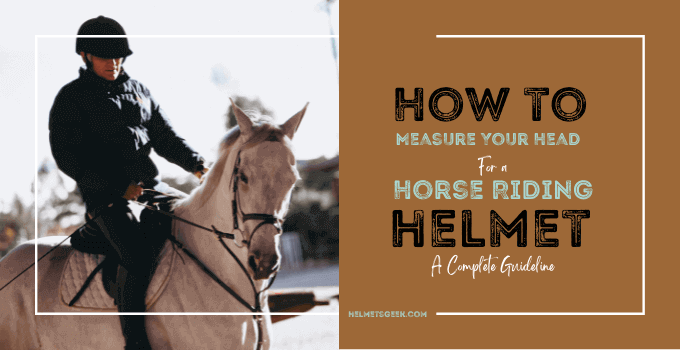How to Measure Your Head For a Horse Riding Helmet-A Complete Guideline
Table of Contents
Most beginner equestrians face problems choosing the helmet size. You are here as you also face the challenge of how to measure your head for a horse riding helmet. If you make the wrong selection, it can spoil the whole fun and enjoyment.
An unfit horse riding helmet is both uncomfortable and risky. But you will be glad to know that you can measure your head for an equestrian helmet within a few easy steps.
For this, just take a soft fabric measuring tape, place it around your head with skull fittings and check the tape number. What number you see will be your head size.
To get a clear guideline, stay tuned to the end of this article to learn how to measure for an equestrian riding helmet.
How To Measure Your Head For a Horse Riding Helmet

Head measuring is very essential to know your ideal helmet sizes. Here we like to share all the basic steps to make your measurement accurate.
Place measuring tape
You have to place the measuring tape loosely like skin-tight around the head. Try to keep it one inch above your eyebrows. You should confirm that the tape covers the back head bump above the ear’s top when you place the tape.
Compare measurement result
Different manufacturers’ helmet sizing is different. Some use head circumference in centimeters to fix helmet size, whereas some brands use universal sizing charts such as small, medium, and large.
You need to compare your favorite manufacturer’s horse riding helmet size chart to find the appropriate one. You will get a wide range of options to choose the best horse riding helmet for kids, youths, adults, and senior citizens because all the horse riding helmet sizes are different from the others. You can use the horse riding size chart to transform your measurement into a standard riding helmet size.
Overview of an Equestrian Helmet Size Chart
| Head Size(cm) | Helmet Size |
| 49 | 6 |
| 50 | 6⅛ |
| 51 | 6¼ |
| 52 | 6⅜ |
| 53 | 6½ |
| 54 | 6⅝ |
| 55 | 6¾ |
| 56 | 6⅞ |
| 57 | 7 |
| 58 | 7⅛ |
| 59 | 7¼ |
| 60 | 7⅜ |
| 61 | 7½ |
| 62 | 7⅝ |
| 63 | 7¾ |
| 64 | 7⅞ |
| 65 | 8 |
Sizes below 55cm are classified for kid horse riding helmet size. We already talked about how to measure for a horse riding helmet. But what if your measurement result remains between two sizes. Don’t worry; just use the ceiling formula. That means you can round the result up to the larger size to get the best snug-fitting helmet for horse riding.
Consider Hairstyle
If you have long and thick hair and buy the exact size according to your measurement, it will tightly fit your skull. That’s why we will recommend you to choose one size bigger for long or thick hair. But if your selected helmet has special features such as SureFit pro elastic straps to adjust different hairstyles, you don’t need to increase helmet size.
Helmet shape
In the market, you will find different shapes of helmets. Some helmets are better for round heads, whereas some are preferable for oval heads. You have to check different brands with different models to find the most suitable helmet for your head shape. There is a different technique to find the right shaped helmet for your head.
Here is the technique when the helmet pushes pressure on your forehead, which means the helmet is too round in shape for your head.
But when the helmet fits sides snugly but rocks front to back, it indicates that this helmet is for an oval-shaped head.
Helmet’s Fitting
The right size helmets fit comfortably on your head and offer an outstanding riding experience. It not only ensures comfort but also covers the whole skull with equal pressure from all sides. The best thing about a correct size equestrian helmet is it removes unnecessary space between the helmet and your head.
If your helmet gets even pressure with lining, it will help to tolerate pressure in time of the accident. Your helmet size is correct when you find no gaps between the helmet and head from all sides. Otherwise, the helmet is small or bigger than your head.
It is a better idea to shake the helmet up and down to check whether it freely slides without moving your skin or not. If it slides, then the helmet is too large for your head. Again shake your head from side to side and up and down. If the helmet does not pivot on the head that means the size is accurate for your head.
You may find a bit larger helmet comfortable. But the problem is that it will gradually become too large for your head. When you use it, the lining breaks in and makes it bigger. A larger helmet wiggles in time of horse riding. That can distract you and has a chance to fall from your head.
Weather consideration
You should also consider weather conditions before choosing your helmet. Such as if you choose an adjustable helmet for hot weather you can select a bit larger size. Because you can tighten the helmets through dials, changeable padding, or ties. But if you don’t like adjustments, then try a different brand to choose the correct size, shape, and style for your riding helmet.
If you choose the helmet for the rainy season, then you should choose a waterproof helmet.
And if you pick the helmet for the winter season, you must check the thick inner pads to keep you warm to prevent suffering from cough and sneezing.
How Should a Horse Riding Helmet Fit
The fittings depend on helmet size and shape. When you choose the right size and shape based on the above tips, it will be fit. But there are some extra factors you should consider to make the helmet fittings more perfect. Such as
Brim
You have to check the front brim to buy the best equestrian helmet. In this case, the brim should be more than two fingers width above your eyebrows. If it is lower than 2 fingers, it has a risk of blocking your vision. So, brim fitting is also essential to make horse riding safe and secure.
Chinstrap
Chinstrap helps to fix your helmet snugly on your head. If your helmet does not come with a harness, a chin strap is essential for its stability. It is not holding your helmet in the correct position but helps derive a comfortable fitting on your head. When you find a perfect size helmet with ideal fitting, you can win the battle of horse riding.
Frequently Asked Questions
What size helmet do I need for a 22-inch head?
You have to go with a 6⅞ – 7 helmet size for your 22-inch head.
Where do you measure your head for a helmet?
You need to measure one inch above the eyebrows and cover the back of the head above the ears top to derive the largest measurement. Repeat the process several times to make the measurement error-free.
What size helmet do I need for a 24-inch head?
For your 24 inches head, you need a helmet that is sized 7⅝ – 7¾.
How do you measure a riding hat?
The process of measuring a riding hat is very simple. Place a measuring tape on your head two inches above the eyebrows and also cover the back head bumps with ear tops. The measurement result is your head size. You can easily compare the head size with the riding hat size chart to pick the correct size hat.
Final Thought
Equestrians become confused about the helmet sizes and that’s why they want to know how to measure your head for a horse riding helmet. After doing intense analysis, we have made the easiest solution to removing your confusion. If you follow this head measuring technique, you can easily choose the correct size horse riding helmet.
A properly fitted helmet is a must for ensuring riders’ safety and comfort. It also improves your horse riding performance. That is why it is a must to follow the above steps to buy the right size helmets. The right size determines perfect fitting, best comfort, and superior safety.


